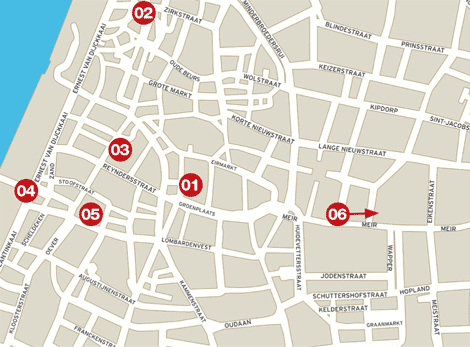
High fashion and a laidback culture draw hordes of visitors to Antwerp. Felicity Cousins takes a shine to the diamond capital of the world

1. Groenplaats
The main square in Antwerp is called Groenplaats, or Green Square, and it provides an excellent jumping-off point for a tour of the city. Originally a cemetery – until the 18th century when the Austrians made it illegal to bury people within the city walls – the square has at its centre a statue of Antwerp’s most famous painter, Peter Paul Rubens, and is dominated by two massive structures, the Grand Bazaar and the Cathedral of Our Lady. The former, built in the 1920s, is now a Hilton hotel, while the latter, a wonderful gothic structure with only one tower (they ran out of money before completing the second) houses four religious works by Rubens and detailed altar carvings by local guilds who used to attend the church. From the square, you can cut through to Grote Markt, the site of the impressive Renaissance Town Hall, built in the1560s, and the Brabo fountain, which depicts the legend from which Antwerp derives its name. According to the story, the city was once terrorised by a giant who cut off the hands of sailors who entered the port city without paying. Silvius Brabo, a Roman soldier, is credited with ending his reign of terror, and the fountain (main picture) shows him throwing the giant’s severed hand into the river. Antwerpen literally means “to throw a hand”.
2. The Vleeshuis
From Grote Markt, wind through the cobbled streets north towards the river and you will come across what looks like a striped Gothic church. Red and white sandstone bricks are layered to give a style known locally as “streaky bacon” – which is singularly appropriate in this case, as the building was originally constructed in 1504 for the Guild of Butchers. The meat was then brought from the slaughterhouse directly into the cool stone marketplace. Although Vleeshuis is now a museum (housing a collection of pianos and Antwerp antiques), inside the original flooring remains and you can almost imagine the knives being sharpened to slice great slabs of meat. The museum is open Tuesday to Sunday 10am-5pm.
3. “Ean terras doen”
“Doing a terrace” is a well-known Antwerp phrase, and all around the city you will see people sitting outside restaurants and bars enjoying a coffee or beer. There are plenty of places to choose from, although the ones on the main squares do tend to get very busy around lunchtime. For an evening meal, one of the most picturesque parts of the city is in the Latin Quarter. Head for Vlaeykensgang Street, an alleyway of traditional houses from the 16th century, once belonging to the shoemakers of the city. Here, the restaurants and bars are set up in original old buildings, serving fantastic Belgian fare.
4. Sint-Anna Tunnel
Walk off your food and drink with a stroll along the waterfront. Currently, the promenade is rather run down, but the city council is working on redevelopment plans for this whole area to bring people back to the river. The only way to cross the river Schelde by foot is through the Sint-Anna (pictured below) – this 1930s tunnel will take you under the river to the other side for good views of the city skyline. The art deco architecture with wooden escalators and lift are original. There’s nothing much on the other side as it is a residential area but many of the locals like to cycle the 572m through the tunnel for a ride around on the left bank. On your return, have a wander around the flea market in the square and search out an antique amid the litter of old books, nuts and bolts.
5. Museum Plantin-Moretus
Christoffel Plantin came to Antwerp in the 16th century and became a printer in 1555. This house, on the Vrijdagmarkt, is where he lived and worked with the family business, expanding once his son-in-law Jan Moretus came on board. Today, it is a wonderful museum with examples of two of the oldest printing presses in the world, made around 1600. There are also a series of type cases filled with type and proofed copies – it is interesting to note how many of the same symbols are still used in modern proof reading. The 17th-century house, with its pretty flower-filled courtyard garden, creaks and groans under the weight of visitors, and each room offers a fascinating insight into the lives of the world-famous printers. Open Tuesday to Sunday 10am-5pm; Entrance is E6 (free the last Wednesday of every month); visit museum.antwerpen.be/plantin_moretus.
6. Meir Street
This is the main street and links the old historical centre to the diamond quarter. It is a fashion-lovers’ paradise, and a walk down here will offer plenty of opportunity for window shopping or popping into tempting boutiques. I found a wonderful design shop of maze-like rooms, with modern eye-catching designs twisting and turning on different levels – by the time you come out you will have mentally decorated your entire house. At the end of Meir Street, before you reach the train station, turn off onto Appelmansstraat to enter the diamond district. Seven out of ten of the world’s diamonds are cut and polished in Antwerp, and the industry has been established and thriving here for 700 years. For a close-up view of the work of the master craftsmen head for Diamond Land, a huge showcase which has free tours to view the cutting and polishing of the stones at 11am. It is open Monday to Saturday 9.30am-5.30pm (and from April to October it is also open on Sundays); visit diamondland.be. It’s also fascinating just to stroll around looking at all the heavily guarded rock shops.








